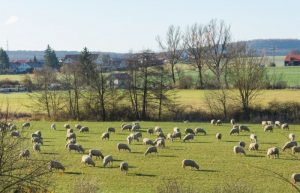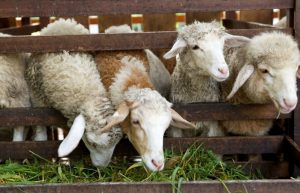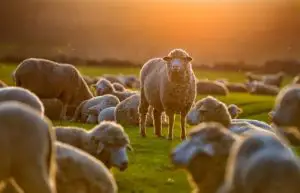How Much Land Do You Need For Your Sheep?
One of the biggest things to consider before purchasing any type of livestock is how much land you have to sustain the animals. Most livestock animals are grazers, meaning they need to eat the majority of the day. When it comes to owning sheep, they are no different. Sheep forage on grass, shrubs, and hay to properly sustain themselves.
How many sheep should you have per acre? One acre of land can usually produce enough forage to sustain two sheep year-round; however, you can keep up to 8-10 sheep on one acre if you regularly rotate your fields and provide extra roughage, like hay.
If you plan on keeping 10 sheep on one acre, you should be prepared to dedicate more finances to the care of your sheep. You will have to purchase hay and grain in order to sustain your sheep’s diet, as 10 sheep can quickly eat down an acre of grass. To learn more about how to sustain your sheep on the land you have, keep reading.
How Much Food Does Your Sheep Need?
Sheep usually eat 2.5 – 3% of their body weight each day; depending on how much you sheep weighs, that means they can be eating 2 – 7 lbs (1 – 3.2 kg) per day. If you have 10 sheep, your flock may require up to 70 lbs (31.8 kg) of food per day!
Herbivores require a larger amount of food and forage to produce the energy they need to survive. When it comes to sheep, the food they eat can be turned into energy to keep them warm, produce milk, grow healthy wool, and stay on alert so they can flee from predators. Because of this, you’ll see sheep grazing and eating for over eight hours a day. In-between eating, sheep will rest and digest, breaking up their grazing into intervals.
What Do Sheep Eat?
If you’re keeping a larger number of sheep on smaller acreage, it’s important to know how you can supplement your sheep’s diets. A large flock can quickly eat down an acre of grass to where it won’t have sufficient forage. Whether you have a large flock of sheep or the winter months have caused forage to stop growing in the pasture, here is a list of what your sheep can eat to sustain their diets.
Grass
The majority of your flock’s diet should rely on vegetation like grass or hay. If your sheep have access to quality pasture, they will usually prefer green grass to hay. Lush and healthy grass will provide you sheep will plenty of natural sugars, proteins, and minerals that, in turn, can be turned into energy as the sheep digests the food.
If your sheep have adequate pasture and water, they may not require any other form of sustenance. Grazing animals can usually get all they need from healthy vegetation. If your flock is only relying on grass for their food, you may consider giving them mineral supplements just to ensure they are getting the minerals and vitamins they need that they may not get just from the grass.
Hay
Hay is basically dried grass. When hay is made, the grass is cut, fluffed, and dried before put into bales for better storage. Hay will still contain the natural sugars, proteins, and minerals that grass has; the only difference is that grass contains more calories than hay. This means that sheep will be able to produce more energy from grass than they would from hay.
What I’ve noticed is that sheep and other livestock will prefer lush green grass to hay. Even when the grass is scarce and there’s a round bale of hay in the pasture, sheep will still take the time to look for the grass they can eat. That being said, hay is the next best solution if you don’t have sustainable grass pasture for your sheep.
Grain
When should you feed your sheep grain? Grain provides a higher concentration of sugar and proteins than any vegetation your sheep will eat. For this reason, it can be used to sustain the sheep’s weight and help them get a source to produce energy. However, too much grain can be bad for your sheep and cause them to become overweight and sick.
Many people will feed grain to their pregnant sheep or to the flock during the winter months when the sheep require more energy to either grow a baby and give birth or to keep warm.
Supplements
Mineral supplements are used to ensure that your sheep are getting minerals that can keep them healthy and strong. With any animal, having a balance of minerals in the diet can greatly improve general health. Sheep mineral supplements come in the form of a salt block that the sheep can lick or as loose salt that can be added to feed and hay to ensure consumption.
How to Utilize Your Pasture When Raising Sheep
 Even when raising a larger flock of sheep on smaller acreage, there are things you can do to make the grass and forage in the pasture go further. With proper management, you can help your pasture sustain more sheep. Here are some things to consider when utilizing your pastures for sheep:
Even when raising a larger flock of sheep on smaller acreage, there are things you can do to make the grass and forage in the pasture go further. With proper management, you can help your pasture sustain more sheep. Here are some things to consider when utilizing your pastures for sheep:
Rotate Your Sheep From Pasture to Pasture
If you’re keeping your flock of sheep in one smaller pasture, the flock can quickly eat down the grass and forage until there is nothing left to sustain them. At this point, your financial obligation will increase with having to purchase hay and grain to provide sustenance for your sheep. If you have a smaller area of acreage for your sheep, one way you can get more out of your pastures is by rotating your sheep from pasture to pasture.
Rotating your sheep enables one pasture to rest while the other is being used. This can lead to healthier grass production as the grass isn’t constantly under the stress of grazing. This will also give the empty pasture time to re-grow lush forage for the next time the sheep are put in there. Ideally, as soon as one pasture is starting to run low on grass, you can rotate the sheep into another pasture that has had time to grow and rest.
Raise Smaller Sheep Breeds
If you have a smaller amount of land to use for your sheep, one option you can choose to utilize your pasture as best as you can is to purchase smaller sheep breeds. Babydoll sheep are one of the smallest sheep breeds there is, with adult babydoll sheep only weighing 60 – 120 lbs (27 – 54 kg) and reaching heights of 18 – 24 inches (46 – 61 cm).
When it comes to larger sheep breeds, one acre of land can only sustain two sheep. With smaller sheep breeds like babydoll sheep, one acre of land can sustain as many as five sheep. This will enable you to raise more animals while also utilizing your pastures more efficiently.
Babydoll sheep can be just as profitable, if not more, than other sheep breeds. They can be used for wool, meat, and breeding, and registered babydoll sheep can usually sell for more than your average sheep. If you want to learn more about babydoll sheep, check out my article How Big Do Babydoll Sheep Get: What You Need to Know.
Plant Certain Types of Grasses for Your Sheep
Different types of grasses produce different amounts of sugars, proteins, and minerals while also only growing for certain seasons, in certain environments, and only to a certain length of the blade. With so many different options when it comes to the vegetation in your pasture, it’s important that you research the type of grass that can best benefit your sheep. Here are some grass and legume choices that can benefit your sheep in small pastures:
Kentucky Bluegrass
Kentucky Bluegrass is one of the most popular grasses eaten by sheep and other livestock and grazing animals. This type of grass is hardy, surviving in both dry and wet environments. This type of grass also deals well with the stress of livestock constantly walking and trampling over it. It is considered a quality grass for your sheep; however, it can be considered an invasive week species, taking over other grass types and vegetation.
Orchardgrass
Orchardgrass is high in sugar, which can be great for sustaining your sheep. It also grows from early in the spring and into the fall. Orchardgrass can produce lush and thick areas of grass, which can provide more forage. Orchardgrass can also produce quality fine hay.
Timothy Grass
Being one of the most inexpensive seeds to purchase, many people will plant timothy grass for their sheep. It also provides a high-energy yield and is easy to digest. The downside to timothy grass is that it doesn’t usually start growing until the late spring or early summer.
Keep Your Sheep With Other Livestock Animals
Maybe you have more acreage that you keep other livestock animals on. While you may want to keep your sheep separate from other animals, it can be difficult to find the extra land once the majority of your pasture is already in use. Did you know that you can use your pastures for multiple livestock animals? Sheep co-exist well with goats, llamas, alpacas, and cattle.
Keeping your sheep with other livestock can give them access to larger pastures and more forage. While sheep can live alongside larger livestock like cattle and llamas, it’s important to watch for sheep getting pushed and run over, especially at feeding time or around the water trough. If this happens, it’s best to keep the sheep separate.
Managing your pastures and livestock can help you create a sustainable method for ensuring that your sheep get the forage and sustenance they need as well as save you some money and resources, like hay and grain.
Frequently Asked Questions
How Much Water Do Sheep Need?
 The amount of water your sheep need each day can vary greatly. In warmer months and during gestation, sheep will consume more water. On average, sheep can consume anywhere from 1/2 – 5 gallons (2 – 19 L) of water a day. Staying hydrated is vital to many livestock, as it enables them to properly digest their food.
The amount of water your sheep need each day can vary greatly. In warmer months and during gestation, sheep will consume more water. On average, sheep can consume anywhere from 1/2 – 5 gallons (2 – 19 L) of water a day. Staying hydrated is vital to many livestock, as it enables them to properly digest their food.
If you want to make sure your sheep are getting proper water intake, make fresh water easily accessible in the pasture. You can also wet down grain and hay which can help sheep consume water.
Can I Keep a Sheep By Itself?
As a prey animal and a herd animal, your sheep should be kept with other sheep or other livestock, like goats. A herd environment helps them to feel secure and safe from predators. A sheep kept by itself or separated from its flock can get depressed and anxious, refusing to eat or drink. It’s said that you should get at least five sheep to create a good herd environment for your flock. To learn more, read my article Can You Keep a Sheep By Itself? Essential Guide.
Do Sheep Need Shelter?
Sheep are hardy animals that can be tolerant to both the cold and the heat. Sheep with wool fleece have extra protection from the elements; however, it’s important that you provide your sheep with adequate shelter like a run-in shed. The biggest reason your sheep need shelter is to help them escape the elements and extreme temperatures.
Sheep that don’t have an escape from the elements can get soaked to the skin by rain or snow, which could lead to hypothermia. A shelter will also enable your sheep to escape the heat and the sun. While wool sheep may be able to insulate their body temperature to some degree, they can become overheated in warm temperatures.
To learn more about whether your sheep need shelter from the rain, check out my article Leaving Sheep Out in the Rain: Everything You Need to Know.
I hope this article was helpful to you in figuring out how much land you need for your sheep. I have written many articles about caring for sheep and other livestock and poultry. To learn more, you can view all my articles by clicking here.

